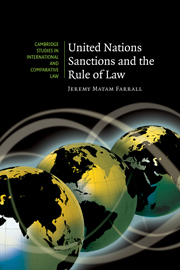Book contents
- Frontmatter
- Contents
- Extended Table of Contents
- Preface
- Abbreviations
- Part I Setting the scene
- Part II The evolution of the UN sanctions framework
- Part III UN sanctions in practice
- Part IV Strengthening the rule of law
- 9 Rule of law weaknesses in the UN sanctions system
- 10 Strengthening the rule of law performance of the UN sanctions system
- 11 Concluding remarks
- Appendix 1 Summary of policy recommendations
- Appendix 2 Summaries of UN sanctions regimes
- Appendix 3 Tables
- Bibliography
- Index
- Cambridge Studies in International and Comparative Law
9 - Rule of law weaknesses in the UN sanctions system
Published online by Cambridge University Press: 26 June 2009
- Frontmatter
- Contents
- Extended Table of Contents
- Preface
- Abbreviations
- Part I Setting the scene
- Part II The evolution of the UN sanctions framework
- Part III UN sanctions in practice
- Part IV Strengthening the rule of law
- 9 Rule of law weaknesses in the UN sanctions system
- 10 Strengthening the rule of law performance of the UN sanctions system
- 11 Concluding remarks
- Appendix 1 Summary of policy recommendations
- Appendix 2 Summaries of UN sanctions regimes
- Appendix 3 Tables
- Bibliography
- Index
- Cambridge Studies in International and Comparative Law
Summary
The previous four chapters have been devoted to describing the UN Security Council's sanctions practice. They have charted the manner in which the Council has acted upon its sanctions powers to weave a web of sanctions obligations. The Council has identified a diverse collection of threats to the peace warranting the application of sanctions. It has created a wide variety of sanctions regimes, consisting of an assortment of measures applied against various targets. The Council has applied sanctions for a wide collection of objectives and has tasked a broad range of actors with responsibility for sanctions administration and monitoring.
Discussion now returns to the relationship between the Security Council's sanctions practice and the rule of law. The pragmatic model of the rule of law constructed in Chapter 2 is now operationalised to examine the extent to which UN sanctions have strengthened the rule of law. This chapter consists of five sections, devoted to the key principles of the rule of law that comprise the pragmatic rule of law model: transparency, consistency, equality, due process and proportionality. Each section critically evaluates the track-record of the UN sanctions system, identifying shortcomings in respect of each principle of the rule of law. Chapter 10 then advances reform proposals designed to increase the capacity of the UN sanctions system to strengthen the rule of law.
Behind closed doors: the problem of transparency
The principle of transparency requires that decision-making concerning the exercise of political power should be as clear and transparent as possible.
- Type
- Chapter
- Information
- United Nations Sanctions and the Rule of Law , pp. 185 - 229Publisher: Cambridge University PressPrint publication year: 2007



